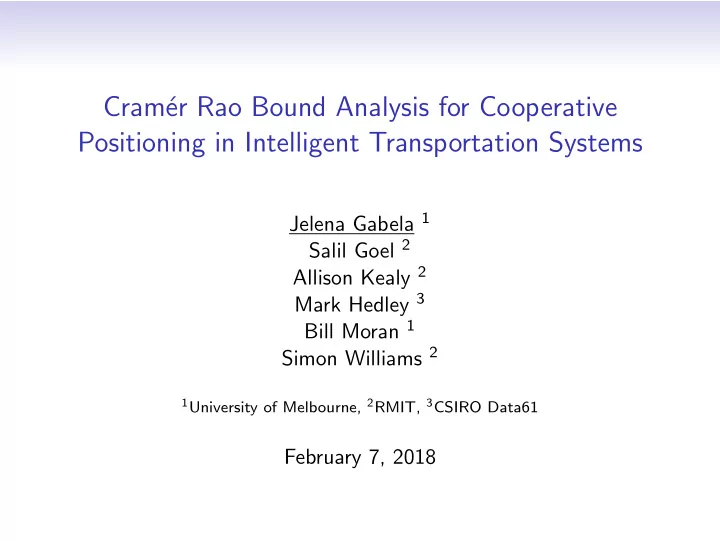

Cram´ er Rao Bound Analysis for Cooperative Positioning in Intelligent Transportation Systems Jelena Gabela 1 Salil Goel 2 Allison Kealy 2 Mark Hedley 3 Bill Moran 1 Simon Williams 2 1 University of Melbourne, 2 RMIT, 3 CSIRO Data61 February 7, 2018
Introduction (1) Urban environment = GNSS challenging environment
Introduction (2) • Intelligent Transport Systems (ITS) • Rigid accuracy, integrity and availability requirements ⇒ Cooperative Positioning (CP) • Aim ⇒ demonstrate benefits of CP in ad-hoc network of 4 vehicles and 15 infrastructure nodes • Posterior Cram´ er Rao Bound → theoretically best achievable performance
Vehicle-to-Infrastructure (V-2-I) cooperative positioning
Vehicle-to-Vehicle (V-2-V) cooperative positioning
V-2-V + V-2-I cooperative positioning
Centralised Cooperative Positioning Framework • Extended Kalman Filter ⇒ integration of GNSS and Ultra-WideBand • Simulated ad-hoc network • 4 mobile nodes ⇒ vehicles • 15 infrastructure nodes • Available measurements • GPS determined positions for 3 vehicles • Relative ranges between all vehicles • Relative ranges between vehicle without GPS and infrastructure nodes
Simulated trajectory (1)
Simulated trajectory (2)
Results (1) Vehicle-to-Infrastructure cooperative positioning
Results (2) Vehicle-to-Infrastructure cooperative positioning
Results (3) Vehicle-to-Infrastructure cooperative positioning
Results (4) Vehicle-to-Infrastructure cooperative positioning
Results (5) Vehicle-to-Vehicle cooperative positioning
Results (6) Vehicle-to-Vehicle cooperative positioning
Results (7) Vehicle-to-Vehicle cooperative positioning
Results (8) V-2-I + V-2-V cooperative positioning
Results (9) V-2-I + V-2-V cooperative positioning
Conclusions and future work • Theoretically best performance • In turns ⇒ less than 40 cm • On straight parts ⇒ ∼ 10 cm • Promising start in developing a cooperative positioning system appropriate for ITS • Fixed network of infrastructure nodes helps to constrain the accuracy of solution • ITS = real-time application ⇒ trustworthiness! • In future: • Integrating existing solution with IMU • Modify EKF - GNSS pseudoranges • Experimental validation and evaluation based on collected data
Thank you!
Recommend
More recommend